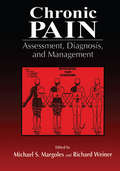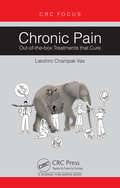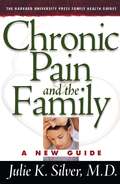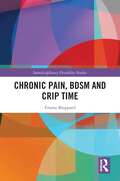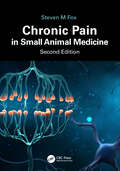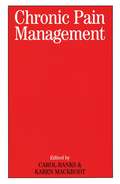- Table View
- List View
Chronic Pain: A Primary Care Guide to Practical Management (Current Clinical Practice)
by Dawn MarcusPatients with chronic pain present a unique set of challenges to the primary care clinician. In Chronic Pain: A Primary Care Guide to Practical Management, leading pain specialist Dawn A. Marcus, MD, offers practical, clear, and succinct evidence-based approaches to the diagnosis and treatment of the myriad of painful conditions clinicians see in their offices every day, such as headache, back pain, arthritis, fibromyalgia, and abdominal pain. Using an engaging case-based approach, the author simplifies the often complex care of patients with chronic pain by providing practical strategies for targeting important symptoms, establishing realistic treatment goals, and efficiently and effectively managing patients. Clinic-friendly instructional sheets (questionnaires, diaries, and chart documentation tools) can be copied directly from the book and used for both education and the monitoring of therapeutic compliance and response. Importantly, Dr. Marcus offers all of these practical applications in the context of the busy office practice. The author also presents invaluable guidelines for prescribing medications and nonmedicative therapies, and provides descriptions, illustrations, and diagnostic criteria to help identify specific, commonly occurring syndromes that produce chronic pain. Additional features include sections on opioid therapy and on chronic pain in special patient groups such as children and adolescents, pregnant women, and geriatrics. Also included is a value-added compact disk containing a companion ebook version of the book for downloading and use in the reader's computer or PDA, and continuing medical education (CME) questions that provide the opportunity to acquire 5 AMA/PRA category 1 CME credits from the American Society of Contemporary Medicine and Surgery. Comprehensive and case-oriented, Chronic Pain: A Primary Care Guide to Practical Management offers busy health care providers a practice-friendly approach to assessing and managing the often complex and time-consuming problems of chronic pain.
Chronic Pain: Assessment, Diagnosis, and Management
by Michael Margoles Richard S. WeinerChronic pain affects every aspect of life-physical well-being, mood, stamina, and feelings of self worth and self respect. This book focuses on conquering pain and its related problems through proper management. It offers numerous tools and concepts with which to attack chronic pain and win the battle that more than 35 million people in the U.S. alone fight every day. Virtually all specialists in the health care field must be concerned with pain management-this complete reference offers them strategies for helping their patients, and for patients to help themselves.Chronic Pain: Assessment, Diagnosis, and Management presents a variety of therapies for combating chronic pain, including:Applying external therapyChanging the way patients perceive pain through psychotherapy or other cognitive meansPhysical therapy and exercisesOver-the-counter or prescription medicines to relieve pain, stress, and insomnia caused by discomfortSurgical optionsThe book also contains never before published information on how to prescribe and administer opioids and opioid-containing analgesics for chronic, intractable, and non-malignant pain patients.There is hope for those suffering from chronic pain. This book outlines commonly overlooked problems that, if properly addressed, can make the difference between a patient recovering or effectively managing their pain-or not. Chronic Pain: Assessment, Diagnosis, and Management is full of practical advice and options for anyone suffering from chronic pain and for the doctors who treat them.
Chronic Pain: Assessment, Diagnosis, and Management
by Michael Margoles Richard S. WeinerChronic pain affects every aspect of life-physical well-being, mood, stamina, and feelings of self worth and self respect. This book focuses on conquering pain and its related problems through proper management. It offers numerous tools and concepts with which to attack chronic pain and win the battle that more than 35 million people in the U.S. alone fight every day. Virtually all specialists in the health care field must be concerned with pain management-this complete reference offers them strategies for helping their patients, and for patients to help themselves.Chronic Pain: Assessment, Diagnosis, and Management presents a variety of therapies for combating chronic pain, including:Applying external therapyChanging the way patients perceive pain through psychotherapy or other cognitive meansPhysical therapy and exercisesOver-the-counter or prescription medicines to relieve pain, stress, and insomnia caused by discomfortSurgical optionsThe book also contains never before published information on how to prescribe and administer opioids and opioid-containing analgesics for chronic, intractable, and non-malignant pain patients.There is hope for those suffering from chronic pain. This book outlines commonly overlooked problems that, if properly addressed, can make the difference between a patient recovering or effectively managing their pain-or not. Chronic Pain: Assessment, Diagnosis, and Management is full of practical advice and options for anyone suffering from chronic pain and for the doctors who treat them.
Chronic Pain: A Drug-Free Way to Feel Better
by Phil Sizer'Buy this book and make sure your doctor reads it too!' Dr Steve Gilbert, former Lead Clinician for Chronic Pain in ScotlandChronic pain is much more common than you might think - it affects nearly one-fifth of the population. Chronic pain is defined as any pain that continues for longer than three months. It has a variety of causes including arthritis, back pain, fibromyalgia, accidents or operations, although sometimes there is no apparent cause.Many people suffering from chronic pain have been told by medical professionals that they are sorry, but 'there's nothing more we can do for you', leaving them feeling abandoned and isolated. If you have been told this, or you think this news may be in your future, then this book is for you.Self-management is an important approach to coping better and managing this long term condition. Written with humour, and making use of cartoons and line drawings, the new edition of this popular and much-loved book encapsulates 20 years of pain management courses given by Phil Sizer at Pain Association Scotland to patients, GPs, and other health professionals. Divided into three sections (Understanding, Managing, Coping), its approach is based on a holistic, bio-psycho-social model of health including CBT (cognitive behavioural therapy), ACT (Acceptance and Commitment Therapy), positive psychology, relaxation, hypnotherapy, motivational interviewing and coaching.From understanding what pain is (and isn't) to managing flare-ups, challenging your beliefs, getting more sleep and relaxation, to accepting help and learning how to be a person again - not a condition - this book shows how things can improve, become different, and most importantly, so much better.
Chronic Pain: Out-of-the-box Treatments that Cure
by Lakshmi Champak VasThe book will reassure those suffering from chronic pain and readers that pains can be treated, and not just be ‘managed’. Contemporary pain management comprises some very sophisticated treatments, which address various parts of the nervous system that have been historically assumed to be responsible for pain. The author's approach is that all neuropathic pains are neuromyopathic with a major muscle pain component where the muscles are the final common factor in all chronic pains. This premise led to the innovation of a new system of pain management, which has been gratifyingly effective, providing cures for many complicated conditions. The book is about the discovery that many types of chronic pain are curable and others easily manageable. The novel concepts developed by the author and her research on pain management are described in this book. These are unique, and will be of interest to doctors, researchers, students, and patients.
Chronic Pain: Out-of-the-box Treatments that Cure
by Lakshmi Champak VasThe book will reassure those suffering from chronic pain and readers that pains can be treated, and not just be ‘managed’. Contemporary pain management comprises some very sophisticated treatments, which address various parts of the nervous system that have been historically assumed to be responsible for pain. The author's approach is that all neuropathic pains are neuromyopathic with a major muscle pain component where the muscles are the final common factor in all chronic pains. This premise led to the innovation of a new system of pain management, which has been gratifyingly effective, providing cures for many complicated conditions. The book is about the discovery that many types of chronic pain are curable and others easily manageable. The novel concepts developed by the author and her research on pain management are described in this book. These are unique, and will be of interest to doctors, researchers, students, and patients.
Chronic Pain and Brain Abnormalities
by Carl Y. SaabIt is only natural for someone in pain to attend to the body part that hurts. Yet this book tells the story of persistent pain having negative effects on brain function. The contributors, all leading experts in their respective fields of pain electrophysiology, brain imaging, and animal models of pain, strive to synthesize compelling and, in some ways, connected hypotheses with regard to pain-related changes in the brain. Together, they contribute their clinical, academic, and theoretical expertise in a comprehensive overview that attempts to define the broader philosophical context of pain (disentangling sensical from nonsensical claims), list the changes known to take place in the brains of individuals with chronic pain and animal models of pain, address the possible causes and mechanisms underlying these changes, and detail the techniques and analytical methods at our disposal to "visualize" and study these changes. - Philosophical and social concepts of pain; testimonials of chronic-pain patients - Clinical data from pain patients' brains - Advances in noninvasive brain imaging for pain patients - Combining theoretical and empirical approaches to the analysis of pain-related brain function - Manipulation of brain function in animal models - Emerging neurotechnology principles for pain diagnostics and therapeutics
Chronic Pain and Family: A Clinical Perspective
by Ranjan RoyChronic pain affects every facet of a patient’s life, and nowhere is this more evident than in the complex arena of family life. Chronic Pain and Family: a Clinical Perspective examines typical family issues associated with prolonged illness, offering realistic ways to approach them in therapy. Informed by current practice and his own experience, noted author/clinician Ranjan Roy brings fresh insights to common pain scenarios and therapeutic impasses, and provides a framework for assessing marital and family relationships when chronic pain is a defining factor. Clinicians will get not only a clearer understanding of sensitive issues, but also effective strategies for engaging clients without turning them off. Coverage includes: - Meanings of pain in relationships - "Who Does What?": exploring changes in family roles - Resistance to treatment: why it occurs and how to work through it - Health concerns and other burdens on well spouses and children - Sexuality, domestic abuse, and other "silent" issues - Case examples demonstrating therapy step-by-step with a range of couples and families For therapists and social workers who deal with this growing population of patients, Chronic Pain and Family: A Clinical Perspective stands at a unique intersection of pain/disability and family resources. Roy’s recognition of the family’s changing demographics together with his synthesis of clinical knowledge make the book suitable for graduate-level courses as well.
Chronic Pain and HIV: A Practical Approach
by Angela G. GiovannielloPatients suffering from HIV/AIDS often experience chronic pain due to the many diseases and infections they pick up as a result of a weakened immune system. It interferes with their quality of life and physical functioning, impacts adherence to antiretroviral therapy and HIV primary care, and is associated with significant psychological/social distress and substance use disorders. Chronic Pain and HIV addresses all these complex issues that can influence pain care that can influence pain care for the patient with HIV and acts both as a primer and a comprehensive review to define the field of chronic pain management. Using a clear, clinical approach, key topics include the following: Musculoskeletal pain in individuals in HIV Headache in individuals with HIV Psychiatric comorbidities among individuals with HIV and chronic pain Potential benefit and harm of prescription opioids in HIV Pain at the end of life in individuals with AIDS Treatment of chronic pain syndromes in the HIV-infected person. Edited by an outstanding team with extensive experience in HIV/AIDS and pain/palliative care, every chapter is written by a world-famous expert in their field who provides a thorough review of the relevant literature, including the very latest in management guidelines from the leading international societies. Perfect for all those in primary care, as well as infectious disease specialists managing patients with HIV/AIDS, Chronic Pain and HIV provides sensible, straightforward clinical advice to ensure the best possible patient management.
Chronic Pain and HIV: A Practical Approach
by Angela G. GiovannielloPatients suffering from HIV/AIDS often experience chronic pain due to the many diseases and infections they pick up as a result of a weakened immune system. It interferes with their quality of life and physical functioning, impacts adherence to antiretroviral therapy and HIV primary care, and is associated with significant psychological/social distress and substance use disorders. Chronic Pain and HIV addresses all these complex issues that can influence pain care that can influence pain care for the patient with HIV and acts both as a primer and a comprehensive review to define the field of chronic pain management. Using a clear, clinical approach, key topics include the following: Musculoskeletal pain in individuals in HIV Headache in individuals with HIV Psychiatric comorbidities among individuals with HIV and chronic pain Potential benefit and harm of prescription opioids in HIV Pain at the end of life in individuals with AIDS Treatment of chronic pain syndromes in the HIV-infected person. Edited by an outstanding team with extensive experience in HIV/AIDS and pain/palliative care, every chapter is written by a world-famous expert in their field who provides a thorough review of the relevant literature, including the very latest in management guidelines from the leading international societies. Perfect for all those in primary care, as well as infectious disease specialists managing patients with HIV/AIDS, Chronic Pain and HIV provides sensible, straightforward clinical advice to ensure the best possible patient management.
Chronic Pain and the Family (The Harvard University Press Family Health Guides)
by Julie K. SilverChronic pain is the leading cause of disability in the United States, affecting as many as 48 million people in this country alone. It can demoralize and depress both patient and family, especially when there is no effective pain control and no hope for relief. Improperly managed, chronic pain can lead to substance abuse (usually painkillers) and to acute psychological and emotional distress. Pain begets stress and stress begets pain in a wretched downward spiral. Silver reviews the causes and characteristics of chronic pain and explores its impact on individual family relationships and on the extended family, covering such issues as employment, parenting, childbearing and inheritance, and emotional health. Silver treats aspects of chronic pain not covered in a typical office visit: how men and women differ in their experience of chronic pain, the effect of chronic pain on a toddler's behavior or an older child's performance in school, the risks of dependence on and addiction to pain medications, and practical ways for relatives beyond the immediate family circle to offer help and support to the person in pain.
Chronic Pain, BDSM and Crip Time (Interdisciplinary Disability Studies)
by Emma SheppardThis book is a critical disability studies examination of the lived experience of chronic pain, engaging with and making a significant contribution to crip theory and the concept of ‘crip time’. Exploring experiences of pain and fatigue for people who live with chronic pain and based on narratives told through in-depth detailed interviews interwoven with theory at the cutting edge of critical disability studies, it demonstrates that our knowledge and understanding of chronic pain is incomplete without a critical disability studies approach. Through conceptualizing the concept of ‘crip time’ via participants’ narratives of living with chronic pain, chronic fatigue, and variable disabilities, this book demonstrates how thinking about chronic pain and fatigue with ‘crip time’ exposes normative, ableist, assumptions underlying both how pain and the ideas of cure and recovery are understood. It will be of interest to all academics and students working in the fields of disability studies, critical disability studies, crip theory, medical sociology, sexuality, and studies of embodiment, corporeality, and temporality more generally.
Chronic Pain, BDSM and Crip Time (Interdisciplinary Disability Studies)
by Emma SheppardThis book is a critical disability studies examination of the lived experience of chronic pain, engaging with and making a significant contribution to crip theory and the concept of ‘crip time’. Exploring experiences of pain and fatigue for people who live with chronic pain and based on narratives told through in-depth detailed interviews interwoven with theory at the cutting edge of critical disability studies, it demonstrates that our knowledge and understanding of chronic pain is incomplete without a critical disability studies approach. Through conceptualizing the concept of ‘crip time’ via participants’ narratives of living with chronic pain, chronic fatigue, and variable disabilities, this book demonstrates how thinking about chronic pain and fatigue with ‘crip time’ exposes normative, ableist, assumptions underlying both how pain and the ideas of cure and recovery are understood. It will be of interest to all academics and students working in the fields of disability studies, critical disability studies, crip theory, medical sociology, sexuality, and studies of embodiment, corporeality, and temporality more generally.
Chronic Pain The Drug-Free Way
by Phil SizerChronic pain affects nearly half the UK population - 43%, or a staggering 28 million people. Chronic pain is defined as any pain that continues for longer than three months. It has a variety of causes including arthritis, back pain, fibromyalgia, accidents or operations, although sometimes there is no apparent cause.Self-management is an important approach to coping better and managing this long term condition. Written with humour, and making use of cartoons and line drawings, this book encapsulates 20 years of pain management courses given by Phil Sizer at Pain Association Scotland to patients, GPs, and other health professionals. Divided into three sections (Understanding, Managing, Coping) Its approach is based on a holistic, bio-psycho-social model of health including CBT (cognitive behavioural therapy), ACT (Acceptance and Commitment Therapy), positive psychology, relaxation, hypnotherapy, motivational interviewing and coaching. Topics include:introduction by Pain Association Scotlandunderstanding chronic pain - definitions, acute vs chronicpacing – how to avoid over-doingrealistic goal-settingstress managementrelaxation and sleepdealing with flare-ups diet and foods to avoidcoping with unhelpful thinking (racing mind, anxiety and negative thoughts)challenging limiting beliefsrelationships with othersaccepting helpimportance of humour – attitude and valuesbeing a person not a condition
Chronic Pain in Small Animal Medicine
by Steven M. FoxOver the past decade, since publication of the first edition of Chronic Pain in Small Animal Medicine, many advances have been made in the discipline of pain management, including embracement under the One Medicine initiative to improve the health and well-being of multiple species. Contributing significantly to this progress is the evidence base provided by multimodal management of chronic diseases such as osteoarthritis, a leading cause of pet euthanasia. These advances are explored in this updated edition, written for the veterinary professional seeking a greater depth of knowledge in the mechanisms of pain accompanying chronic disease states and the potential targets for treatment. Additional new sections describe newer drugs that are now in wide use, the Canine Osteoarthritis Staging Tool (COAST), novel approaches to cancer treatment, and cannabinoids and their functions. The book goes beyond common protocols by focusing on the latest evidence and our understanding of 'why and how to treat'. It describes and evaluates current physiological and biochemical theories of pain transmission without losing sight of the practical need for such information. Chronic Pain in Small Animal Medicine provides a foundation for advances in animal care and welfare and is necessary reading for veterinarians in practice and training. We’re living in an age of exciting, new discoveries, but these are only exciting if we are aware of these offerings and their optimal indications for use. This book aims to open veterinarians' eyes to the myriad new ways we can now treat chronic pain in small animals.
Chronic Pain in Small Animal Medicine
by Steven M. FoxOver the past decade, since publication of the first edition of Chronic Pain in Small Animal Medicine, many advances have been made in the discipline of pain management, including embracement under the One Medicine initiative to improve the health and well-being of multiple species. Contributing significantly to this progress is the evidence base provided by multimodal management of chronic diseases such as osteoarthritis, a leading cause of pet euthanasia. These advances are explored in this updated edition, written for the veterinary professional seeking a greater depth of knowledge in the mechanisms of pain accompanying chronic disease states and the potential targets for treatment. Additional new sections describe newer drugs that are now in wide use, the Canine Osteoarthritis Staging Tool (COAST), novel approaches to cancer treatment, and cannabinoids and their functions. The book goes beyond common protocols by focusing on the latest evidence and our understanding of 'why and how to treat'. It describes and evaluates current physiological and biochemical theories of pain transmission without losing sight of the practical need for such information. Chronic Pain in Small Animal Medicine provides a foundation for advances in animal care and welfare and is necessary reading for veterinarians in practice and training. We’re living in an age of exciting, new discoveries, but these are only exciting if we are aware of these offerings and their optimal indications for use. This book aims to open veterinarians' eyes to the myriad new ways we can now treat chronic pain in small animals.
Chronic Pain in Small Animal Medicine
by Steven M. FoxChronic pain is unlike acute pain, it lasts beyond the time necessary for healing and resists normal treatment. No one patient feels pain in the same way and yet in veterinary medicine the patient's gain is generally assessed based on a single standard.There is an increasing focus in veterinary medicine on measuring and resolving pain and suffering
Chronic Pain Management
by Carol Banks Karen MacKrodtThis book introduces the reader to the complexities and management of chronic/persistent pain. Chronic pain affects one in seven in the UK population and can be experienced as a symptom of disease or trauma but can also exist without the presence of either of these. This is aimed at non-specialist working in all areas of health care who want to know more about this complex problem. This book begins by exploring models of care and introduces the reader to the biopsychosocial model before going on to explain the physiology of pain. Further chapters explore the snuffer's experience, the appraisal of pain, and barriers to effective pain management and treatment strategies.
Chronic Pain Management for the Hospitalized Patient
by Richard W. Rosenquist, Dmitri Souzdalnitski and Richard D. UrmanUp to 35% of adults suffer from chronic pain, and a substantial number of these patients are admitted to hospitals every year. A major concern of these patients is whether the pain will be adequately controlled during hospitalization. these patients are more likely to have poor pain control and may experience an exacerbation of their co-exisitng chronic pain condition during hospital admission. Adequate pain control is directly related to clinical outcomes, length of hospital stay, and patient satisfaction. A considerable body of evidence demonstrates the medical, social, and economic benefits of satisfactory inpatient pain control. Currently, there are limited pain control guidelines to address this challenging inpatient population. In fact, there are no guidelines outlinign best practices for postoperative pain control in patients with chronic pain. The complex nature of chronic pain and a dearth of publications addressing the concerns of these patients make the creation of relevant guidelines difficult. The goal of this book is to equip clinicians to provide safe and effective management of hospitalized patients with co-existing chronic pain. Each chapter addresses a particular clinical question and is written by an expert in the field. Chapters describe basic principles and specific clinical situations commonly encountered during the care of patients with co-existing chronic pain in hospital settings.
Chronic Pain Management for the Hospitalized Patient
Up to 35% of adults suffer from chronic pain, and a substantial number of these patients are admitted to hospitals every year. A major concern of these patients is whether the pain will be adequately controlled during hospitalization. these patients are more likely to have poor pain control and may experience an exacerbation of their co-exisitng chronic pain condition during hospital admission. Adequate pain control is directly related to clinical outcomes, length of hospital stay, and patient satisfaction. A considerable body of evidence demonstrates the medical, social, and economic benefits of satisfactory inpatient pain control. Currently, there are limited pain control guidelines to address this challenging inpatient population. In fact, there are no guidelines outlinign best practices for postoperative pain control in patients with chronic pain. The complex nature of chronic pain and a dearth of publications addressing the concerns of these patients make the creation of relevant guidelines difficult. The goal of this book is to equip clinicians to provide safe and effective management of hospitalized patients with co-existing chronic pain. Each chapter addresses a particular clinical question and is written by an expert in the field. Chapters describe basic principles and specific clinical situations commonly encountered during the care of patients with co-existing chronic pain in hospital settings.
Chronic Pain Management in General and Hospital Practice
by Koki Shimoji Antoun Nader Wolfgang HamannThis book covers a range of topics, from the cause and identity of pain, to pain relief management. Starting from the mechanism of pain, it continues to pain management techniques such as nerve blocks, drugs (pain killers), noninvasive manipulations psychological techniques and electric management, before describing the management of various painful conditions such as headaches, back pain, extremities pain, post-herpetic pain or complex regional pain syndrome. It also provides the format of case reports which can be used to explain management options. A novel feature of the book is that it provides additional insights into how clinicians involve patients in treating their own pain through guided self-assessment and self-management. Recent studies have revealed that pain is not only a biological alarm that warns of disease, but can also be the disease itself, or the catalyst of a vicious circle of pain and disease. Providing rapid pain relief is often effective in sparking the rapid recovery from various diseases. This book offers the perfect guide for all clinicians, not only those working at pain clinics but all those who have to treat patients who are in pain.
Chronic Pancreatitis: Research and Clinical Management
by H. G. Beger M. Büchler H. Ditschuneit P. MalfertheinerChronic Pancreatitis: From Basic Research to Clinical Treatment
by Zhao-Shen Li Zhuan Liao Jian-Min Chen Claude FérecThis book is a concise guide to the clinical diagnosis and management of chronic pancreatitis, presenting the latest research into the disease. It focuses on pathogenesis, epidemiology, genetics, diagnosis, endoscopic and surgical treatment, and prognosis. It also offers comprehensive descriptions of 4 diagnostic methods and discusses the contemporary management of chronic pancreatitis, including conservative, ESWL, interventional and surgical treatments. The final chapter includes 6 typical case presentations, which taken together provide a standard description of this condition.
Chronic Pelvic Pain: Evaluation and Management
by David L. Olive Richard E. BlackwellA clinically oriented, multi-disciplinary approach to the diagnosis, treatment, and management of chronic pelvic pain in women -- one of the most common problems encountered in the practice setting. The editors present this challenging and often vexing subject in a user-friendly, highly illustrated text, with chapters on: physiology of pain; pain associated with endometriosis; pain associated with fibroids; surgical management; the role of office based surgery; the role of the psychiatrist in pain management; pelvic pain of urinary origin; pelvic pain of gastrointestinal origin. Designed to be part of everyday practice, this is a must for all clinicians in obstetrics-gynaecology, as well as for any physician involved in the health care of women.
Chronic Pelvic Pain (GIP - Gynaecology in Practice #5)
by Paolo VercelliniA new addition to the Gynecology in Practice series, Chronic Pelvic Pain provides a practical guide to diagnosing and treating chronic pelvic pain in women. Emphasizing diagnosis, management and psychological aspects, the book assists gynecologists to better care for their patients suffering from this condition. As a part of the series, various feature boxes are highlighted throughout. "Tips and Tricks" give suggestions on how to improve outcomes through practical technique or patient questioning. In addition, "Caution" warning boxes supply helpful advice on how to avoid problems and "Science Revisited" boxes offer quick reminders of the basic science principles necessary for understanding the presented concepts.

